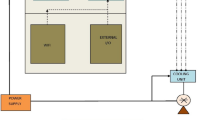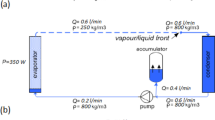Abstract
A thermal module was designed to transfer heat efficiently from high power dissipation chips to a liquid coolant via forced convection. Turbulent and laminar flow regimes were investigated. Channel geometries for deep channels (1000 μm deep, and used for turbulent flow), and shallow channels (100 μm deep, and used for laminar flow) were optimized for high heat transfer coefficient, ease of fabrication, and better structural rigidity of the module. A 4″ x 4″ module, made out of Cu, was tested using a 4″ Si “thermal” wafer as a heat generating source as well as a temperature sensor. Wafer scale integration and high energy ion implantation were employed to obtain nine l x l cm heat sources, and temperature sensing diodes embedded within the thermal wafer. For the deep channel design, the maximum device temperature rise on the module was 18° C for a power dissipation of 42 W/chip, and a flow rate of 126 cc/sec. For the shallow channel design, the temperature rise was 19° C for a flow rate of 19 cc/sec, and a power dissipation level of 42 W/chip. With all nine chips on the thermal module powered to 42 W/chip, the maximum chip to chip temperature variations were found to be 2 and 8° C for deep and shallow channel designs, respectively.
Similar content being viewed by others
References
A. Reisman, Proc. of IEEE,71, 550 (1983).
M. Mahalingam, Proc. IEEE73, 1396 (1985).
S. Oktay, R. Hannemann, and A. Bar-Cohen, Mech. Eng. 36 (1986).
M. S. Pittler, D. M. Powers, and D. L. Schnabel, IBM J. Res. Develop.,26, 2 (1982).
R. D. Danielson, N. Krajewski, and J. Brost, Electron. Packaging and Production 44 (1986).
S. M. Sze, editor, VLSI Technology, New York, McGraw-Hill Book Co., 1983, pp. 624–627.
D. B. Tuckerman and R. F. W. Pease, IEEE Electron Device Lett.EDL-2, 126 (1981).
D. B. Tuckerman, Heat-Transfer Microstructure for Integrated Circuits, PhD Thesis, Dept. of Electrical Engineering, Stanford University, Feb. 1984.
T. Kishimoto and T. Ohsaki, Proc. of 36th IEEE Electronics Component Conference (ECC), pp. 595–601, May 1986.
A. J. Blodget and R. Barbour, IBM J. Res. Develop.26, 30 (1982).
S. Oktay and H. C. Kammerer, IBM J. Res. Develop.26, 55 (1982).
L. Hwang, I. Turlik, and A. Reisman, to be published.
G. Wallis and D. I. Pomerantz, J. Appl. Phys.40, 3946 (1969).
T. J. Moore, “Welding and Brazing of Silicon Carbide,” NASA Tech. Briefs, pp. 118–119, July/Aug. 1986.
J. B. Lasky, Appl. Phys. Lett.,48, 78 (1986).
R. K. Shah, and A. L. London, Laminar Flow Forced Convection in Ducts, New York, Academic Press, 1978.
B. S. Petukhov, “Heat Transfer and Friction in Turbulent Pipe Flow with Variable Physical Properties,” Advances in Heat Transfer, vol. 6, Academic Press, 1970.
B. Gebhart, Heat Transfer, New York, McGraw-Hill, 1971, pp. 48–56.
J. J. Dongarra, C. B. Moler, J. R. Bunch, and G. W. Stewart, Linpack User’s Guide, Philadelphia, Siam, 1979.
Fox and McDonald, Introduction to Fluid Mechanics, 3rd edition, New York, Wiley, 1985.
F. F. Oettinger, Solid State Technol., pp. 169–179, Feb. 1984.
A. Reisman, M. Berkenblit, C. J. Merz, and A. K. Ray, J. Electron. Mater.11, 391 (1982).
B. J. Shanker and R. T. Lambertson, “Sources of Error in Package Thermal Resistance Measurement,” Proc. 36th IEEE Electronics Component Conference (ECC), pp. 161–167, May 1986.
S. M. Sze, Physics of Semiconductor Devices, New York, WileyInterscience Publication, 1981, pp. 32–33, 96–108.
E. S. Schlig, IEEE J. Solid-State CircuitsSC-3, 271 (1968).
PREDICT (Process Estimator for the Design of Integrated Circuit Technologies) is a trademark of the Microelectronics Center of North Carolina, P.O. Box 12889, Research Triangle Park, NC 27709.
Author information
Authors and Affiliations
Rights and permissions
About this article
Cite this article
Nayak, D., Hwang, LT., Turlik, I. et al. A high-performance thermal module for computer packaging. J. Electron. Mater. 16, 357–364 (1987). https://doi.org/10.1007/BF02657911
Received:
Issue Date:
DOI: https://doi.org/10.1007/BF02657911




